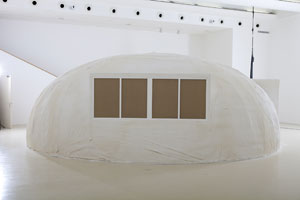Adam Rabinowitz | The Second Strike
Je T’aime Je T’aime, 2011
Wood, metal, fiberglass, polyurethane foam,glass, plastic, slide projection, clay, plaster,
Sweet potato, paper, paint

Adam Rabinowitz’s work offers a double feature relying on the tension between exterior and
interior. First we see the dome-like structure. By itself the domed structure is reminiscent of various structures: a Jewish saint’s tomb, nuclear reactor , industrial plant, wiretapping facility, spaceship or submarine. But the thought of reproduction and dislocation of existing installations arises only to be rejected. Ultimately the structure’s ability to evoke associations to what it is not bolsters its standing as a unique, imagined architectural presence. Some of the associations prompted by the structure appear on a one to one scale, while others are diminished. From the outside, the closed structure reveals nothing of what is going on inside. It does hint at functionality, but not unequivocally. From a formal aspect, the structure is related to ecological architecture and practices of rapid construction. It bears reference to a natural space and to a social situation, to a state of war (the structure as a type of bunker) and to a ritual state (the structure as shrine). It projects towards a world of images that is futuristic, as it is also primordial and tribal. As opposed to the exterior, the spatial experience which takes place inside the structure attempts to sketch a dream territory by means of projected lights, which pass through painted screens, turning the three-dimensional space into two-dimensional shadows, into appearances devoid of substantiality.
Entering the structure is detachment from and the disappearance of the real world. More than they simulate a cave, the space and its changing surfaces seek to drive a transformation towards imaginary internal spaces (nasal passages, the whale’s belly), and new conception of matter, and therefore of sculpture as a spatio-temporal constantly changing experiment.